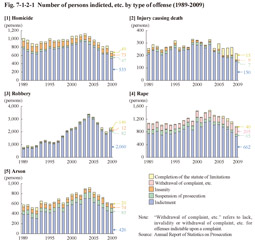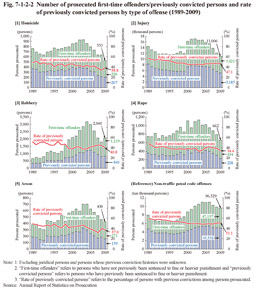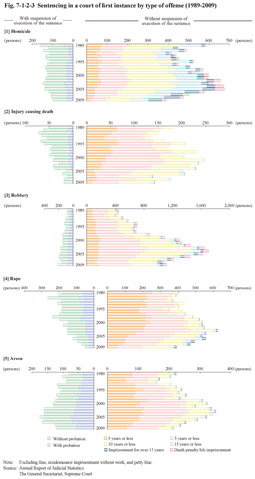Section 2 Prosecution/Trial
Serious offenses that can be a threat to the security of the people generally get severely condemned and heavy statutory penalties therefore imposed. Amendment of the Penal Code by Act No. 156 in 2004 raised the lower limit of the statutory penalty for homicide from imprisonment with work for three years to for five years, and that for injury causing death and rape from imprisonment with work for two years to for three years. In addition, and not limited to these offenses, the upper limit of the term of imprisonment with or without work for a definite term was raised from 15 years to 20 years. In contrast to that however, the lower limit of the statutory penalty for robbery causing injury was lowered from imprisonment for seven years to for six years in thus enabling suspension of execution of sentence to be granted.
Fig. 7-1-2-1 shows the number of persons indicted, etc. for serious offenses by type of offense in and after 1989. The suspended prosecution rate was remarkably low for homicide, injury causing death, robbery, and rape (that for all non-traffic penal code offenses was 43.2% in 2009; See Appendix 2-3). In addition, quite a large number of persons were not prosecuted for homicide and arson due to being insane.
Fig. 7-1-2-1 Number of persons indicted, etc. by type of offense (1989-2009)
Fig. 7-1-2-2 shows the number of first-time offenders/previously convicted persons (based on whether the person concerned had previously been sentenced to fine or heavier punishment in a final judgment or not) prosecuted and the rate of previously convicted persons (percentage of previously convicted persons to total persons prosecuted) by type of offense in and after 1989. The rate of previously convicted persons of those prosecuted for serious offenses (excluding injury causing death for which no statistical data was available) was lower than that for all non-traffic penal code offenses, which is probably due to that persons who committed serious offenses get prosecuted in most cases regardless of the history of their previous conviction.
Fig. 7-1-2-2 Number of prosecuted first-time offenders/previously convicted persons and rate of previously convicted persons by type of offense (1989-2009)
Fig. 7-1-2-3 shows the sentencing in a court of first instance by type of offense in and after 1989.
The sentencing for homicide, injury causing death, robbery, and rape has been more severe in recent years. The probation rate however does significantly vary from year to year, with that for homicide (27.6% in 2009), robbery (39.4% (id.)), rape (50.0% (id.)), and arson (47.9% (id.)) being generally higher than that for all penal code offenses excluding negligence in vehicle driving / negligence in the pursuit of social activities causing death or injury (12.9% (id.)) (See Table 2-3-2-1).
Fig. 7-1-2-3 Sentencing in a court of first instance by type of offense (1989-2009)


